Clay Mineral Suites in Submarine Mud Volcanoes in the Kumano Forearc Basin, Nankai Trough: Constraints on the Origin of Mud Volcano Sediments
Abstract
1. Introduction
2. Geologic Setting and Previous Studies
3. Materials and Methods
3.1. Sediment Cores
3.2. Porewater Samples
3.3. Clay Mineral Assemblage
4. Results
4.1. Porewater Chemistry
4.2. Clay Mineral Assemblage
5. Discussion
6. Conclusions
Supplementary Materials
Author Contributions
Acknowledgments
Conflicts of Interest
References
- Dimitrov, L.I. Mud volcanoes—The most important pathway for degassing deeply buried sediments. Earth-Sci. Rev. 2002, 59, 49–76. [Google Scholar] [CrossRef]
- Wallmann, K.; Drews, M.; Aloisi, G.; Bohrmann, G. Methane discharge into the Black Sea and the global ocean via fluid flow through submarine mud volcanoes. Earth Planet. Sci. Lett. 2006, 248, 544–559. [Google Scholar] [CrossRef]
- Kaul, N.; Foucher, J.-P.; Heesemann, M. Estimating mud expulsion rates from temperature measurements on Håkon Mosby Mud Volcano, SW Barents Sea. Mar. Geol. 2006, 229, 1–14. [Google Scholar] [CrossRef]
- Martin, J.B.; Kastner, M.; Henry, P.; LePichon, X.; Lallement, S. Chemical and isotopic evidence for sources of fluids in a mud volcano field seaward of the Barbados accretionary wedge. J. Geophys. Res. Solid Earth 1996, 101, 20325–20345. [Google Scholar] [CrossRef]
- Dahlmann, A.; de Lange, G.J. Fluid-sediment interactions at Eastern Mediterranean mud volcanoes: A stable isotope study from ODP Leg 160. Earth Planet. Sci. Lett. 2003, 212, 377–391. [Google Scholar] [CrossRef]
- Hensen, C.; Wallmann, K.; Schmidt, M.; Ranero, C.R.; Suess, E. Fluid expulsion related to mud extrusion off Costa Rica—A window to the subducting slab. Geology 2004, 32, 201–204. [Google Scholar] [CrossRef]
- Hensen, C.; Nuzzo, M.; Hornibrook, E.; Pinheiro, L.M.; Bock, B.; Magalhaes, V.H.; Brückmann, W. Sources of mud volcano fluids in the Gulf of Cadiz—Indications for hydrothermal imprint. Geochim. Cosmochim. Acta 2007, 71, 1232–1248. [Google Scholar] [CrossRef]
- Pape, T.; Geprägs, P.; Hammerschmidt, S.; Wintersteller, P.; Wei, J.; Fleischmann, T.; Bohrmann, G.; Kopf, A.J. Hydrocarbon seepage and its sources at mud volcanoes of the Kumano forearc basin, Nankai Trough subduction zone. Geochem. Geophys. Geosyst. 2014, 15, 2180–2194. [Google Scholar] [CrossRef]
- Jurado-Rodriguez, M.J.; Martinez-Ruiz, F. Some clues about the Napoli and Milano mud volcanoes from an integrated log-core approach. In Proceedings of the Ocean Drilling Program Scientific Results; Robertson, A.H.F., Emeis, K.-C., Richter, C., Camerlenghi, A., Eds.; Drilling Program: College Station, TX, USA, 1998; Volume 160, pp. 607–624. [Google Scholar]
- Schulz, H.-M.; Emeis, K.-C.; Volkmann, N. Organic carbon provenance and maturity in the mud breccia from the Napoli mud volcano: Indicators of origin and burial depth. Earth Planet. Sci. Lett. 1997, 147, 141–151. [Google Scholar] [CrossRef]
- Alaoui Mhammedi, N.; El Moumni, B.; El Hmaidi, A.; Raissouni, A.; El Arrim, A. Mineralogical and geochemical study of mud volcanoes in north Moroccan Atlantic margin. Afr. J. Environ. Sci. Technol. 2008, 2, 387–396. [Google Scholar]
- Morita, S.; Ashi, J.; Aoike, K.; Kuramoto, S. Evolution of Kumano Basin and Sources of Clastic Ejecta and Pore Fluid in Kumano Mud volcanoes, Eastern Nankai Trough. In Proceedings of the International Symposium on Methane Hydrates and Fluid Flow in Upper Accretionary Prisms (Prism Fluid 2004), Kyoto, Japan, 9 March 2004. [Google Scholar]
- Menapace, W.; Völker, D.; Kaul, N.; Tryon, M.D.; Kopf, A.J. The role of mud volcanism and deep-seated dewatering processes in the Nankai Trough accretionary prism and Kumano Basin, Japan. Geochem. Geophys. Geosyst. 2017, 18, 2486–2509. [Google Scholar] [CrossRef]
- Tsuji, T.; Ashi, J.; Strasser, M.; Kimura, G. Identification of the static backstop and its influence on the evolution of the accretionary prism in the Nankai Trough. Earth Planet. Sci. Lett. 2015, 431, 15–25. [Google Scholar] [CrossRef]
- Ijiri, A.; Inagaki, F.; Kubo, Y.; Adhikari, R.R.; Hattori, S.; Hoshino, T.; Imachi, H.; Kawagucci, S.; Morono, Y.; Ohtomo, Y.; et al. Deep-biosphere methane production stimulated by geofluids in the Nankai accretionary complex. Sci. Adv. 2018, 4. [Google Scholar] [CrossRef]
- Nishio, Y.; Ijiri, A.; Toki, T.; Morono, Y.; Tanimizu, M.; Nagaishi, K.; Inagaki, F. Origins of lithium in submarine mud volcano fluid in the Nankai accretionary wedge. Earth Planet. Sci. Lett. 2015, 414, 144–155. [Google Scholar] [CrossRef]
- Manheim, F.T.; Sayles, F.L. Composition and origin of interstitial waters of marine sediments, based on deep sea drill cores. In The Sea, Volume 5: Marine Chemistry; Goldberg, E.D., Ed.; Wiley Interscience: New York, NY, USA, 1974; pp. 527–568. [Google Scholar]
- Itai, T.; Kusakabe, M. Some practical aspects of an on-line chromium reduction method for D/H analysis of natural waters using a conventional IRMS. Geochem. J. 2004, 38, 435–440. [Google Scholar] [CrossRef]
- Guo, J.; Underwood, M.B. Data report: Clay Mineral Assemblages from the Nankai Trough Accretionary Prism and the Kumano Basin, IODP Expeditions 315 and 316, NanTroSEIZE Stage 1. Available online: http://publications.iodp.org/proceedings/314_315_316/ERR/CHAPTERS/314315316_202.PDF (accessed on 15 June 2018).
- Underwood, M.B.; Basu, N.; Steurer, J.; Udas, S. Data report: Normalization factors for semiquatitative X-ray diffraction analysis, with application to DSDP site 297, Shikoku Basin. In Proceedings of the ODP, Science Results, 190/196; Mikida, H., Moore, G.F., Taira, A., Becker, K., Moore, J.C., Klaus, A., Eds.; Ocean Drilling Program: College Station, TX, USA, 2003; pp. 1–28. [Google Scholar]
- Biscaye, P.E. Mineralogy and sedimentation of recent deep-sea clay in the Atlantic Ocean and adjacent seas and oceans. Geol. Soc. Am. Bull. 1965, 76, 803–832. [Google Scholar] [CrossRef]
- Moore, D.M.; Reynolds, R.C., Jr. X-ray Diffraction and the Identification and Analysis of Clay Minerals, 2nd ed.; Oxford University Press: New York, NY, USA, 1997; pp. 270–276. [Google Scholar]
- Rettke, R.C. Probable burial diagenetic and provenance effects on Dakota Group clay mineralogy, Denver Basin. J. Sediment. Petrol. 1981, 51, 541–551. [Google Scholar] [CrossRef]
- Weaver, C.E. Possible uses of clay minerals in search for oil. AAPG Bull. 1960, 44, 1505–1518. [Google Scholar]
- Kastner, M.; Elderfield, H.; Martin, J.B. Fluids in convergent margins: What do we know about their composition, origin, role in diagenesis and important for oceanic chemical fluxes? Philos. Trans. R. Soc. Lond. 1991, A335, 243–259. [Google Scholar] [CrossRef]
- Yeh, H.W. D/H Ratios and Late-Stage Dehydration of Shales during Burial. Geochim. Cosmochim. Acta 1980, 44, 341–352. [Google Scholar] [CrossRef]
- Kinoshita, M.; Tobin, H.; Ashi, J.; Kimura, G.; Lallemant, S.; Screaton, E.J.; Curewitz, D.; Masago, H.; Moe, K.T.; The Expedition 314/315/316 Scientists. Proceedings of the Integrated Ocean Drilling Program, 314/315/316; Ocean Drilling Program: College Station, TX, USA, 2009. [Google Scholar]
- Hower, J.; Eslinger, E.; Hower, M.E.; Perry, E.A. Mechanism of burial metamorphism of argillaceous sediment: 1. Mineralogical and chemical evidence. GSA Bull. 1976, 87, 725–737. [Google Scholar] [CrossRef]
- Pytte, A.M.; Reynolds, R.C. The thermal transformation of smectite to illite. In Thermal History of Sedimentary Basins; Naeser, N.D., McCulloh, T.H., Eds.; Springer: Berlin, Germany, 1989; pp. 133–140. [Google Scholar]
- Perry, E.A.; Hower, J. Late-stage dehydration in deeply buried pelitic sediments. AAPG Bull. 1972, 56, 2013–2021. [Google Scholar]
- Eberl, D.; Hower, J. Kinetics of illite formation. Geol. Soc. Am. Bull. 1976, 87, 1326–1330. [Google Scholar] [CrossRef]
- Freed, R.L.; Peacor, D.R. Geopressured shale and sealing effect of the smectite to illite transition. AAPG Bull. 1989, 73, 1223–1232. [Google Scholar]
- Huang, W.L.; Longo, J.M.; Pevear, D.V. An experimentally derived kinetic model for smectite-to-illite conversion and its use as a geothermometer. Clays Clay Miner. 1993, 41, 162–177. [Google Scholar] [CrossRef]
- Underwood, M.B.; Pickering, K.; Gieskes, J.M.; Kastner, M.; Orr, R. Sediment geochemistry, clay mineralogy, and diagenesis: A synthesis of data from Leg 131, Nankai Trough. In Proceedings ODP Science Results, 131; Hill, I.A., Taira, A., Firth, J.V., Berner, U., Bruückmann, W., Byrne, T., Chabernaud, T., Fisher, A., Foucher, J.-P., Gamo, T., et al., Eds.; Ocean Drilling Program: College Station, TX, USA, 1993; pp. 343–363. [Google Scholar]
- Ujiié, Y. Mud diapirs observed in two piston cores from the landward slope of the northern Ryukyu Trench, northwestern Pacific Ocean. Mar. Geol. 2000, 163, 149–167. [Google Scholar] [CrossRef]
- Saffer, D.; McNeill., L.; Byrne, T.; Araki, E.; Toczko, S.; Eguchi, N.; Takahashi, K.; The Expedition 319 Scientists. Proceedings of the Integrated Ocean Drilling Program 319; Ocean Drilling Program: College Station, TX, USA, 2010. [Google Scholar]
- Saffer, D.M.; Tobin, H.J. Hydrogeology and mechanics of subduction zone forearcs: Fluid flow and pore pressure. Annu. Rev. Earth Planet. Sci. 2011, 39, 157–186. [Google Scholar] [CrossRef]
- Hüpers, A.; Kopf, A.J. Effect of smectite dehydration on pore water geochemistry in the shallow subduction zone: An experimental approach. Geochem. Geophys. Geosyst. 2012, 13. [Google Scholar] [CrossRef]
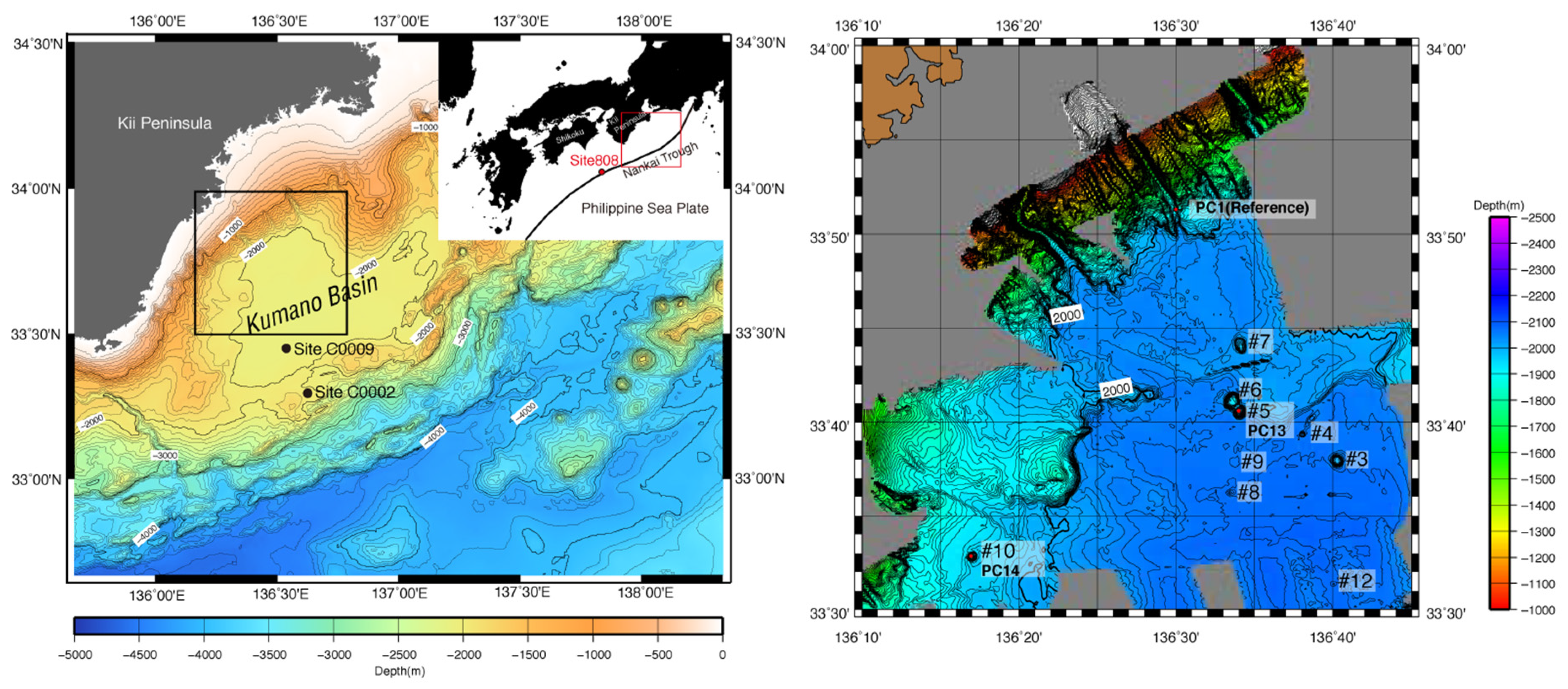
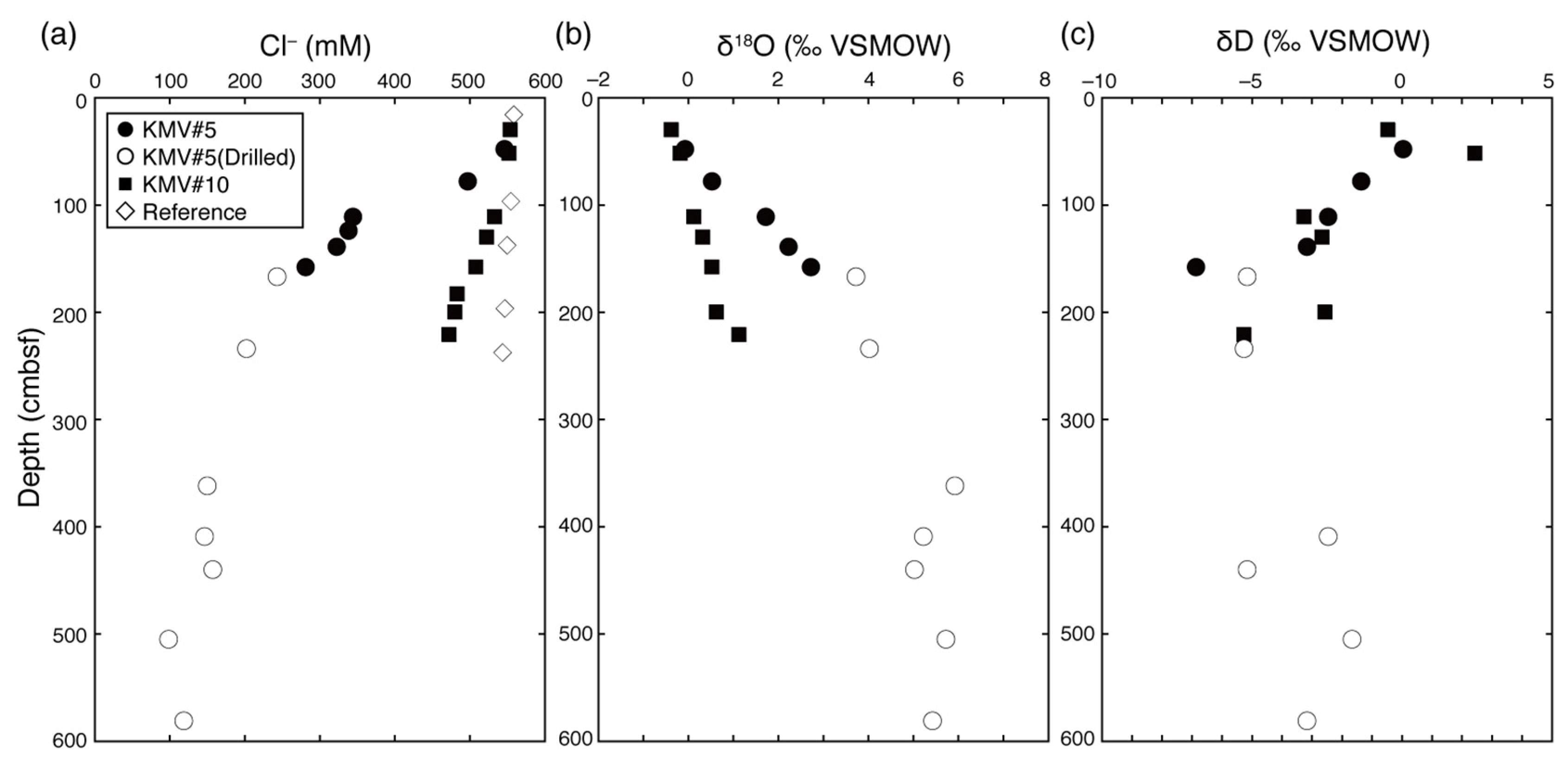
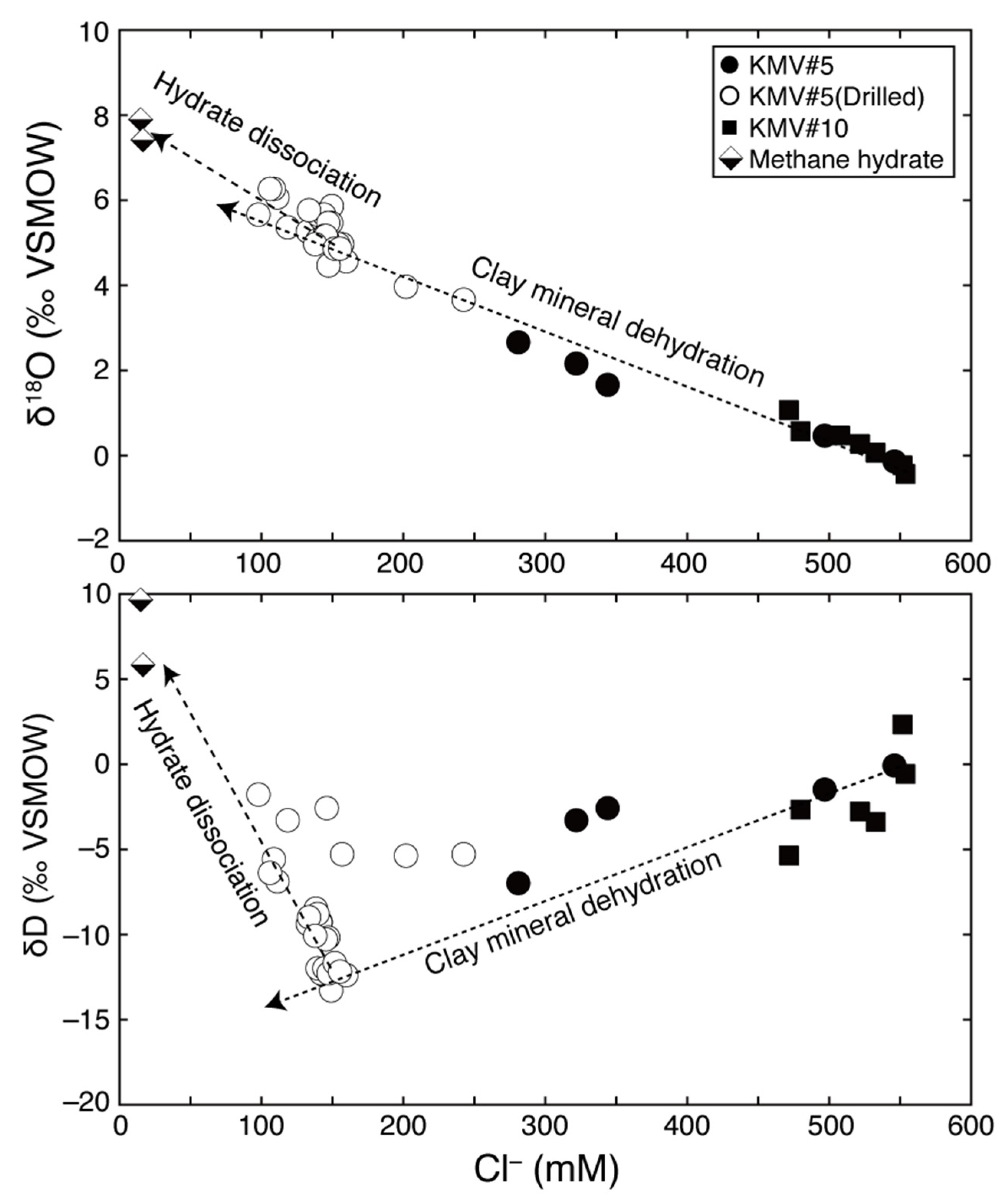

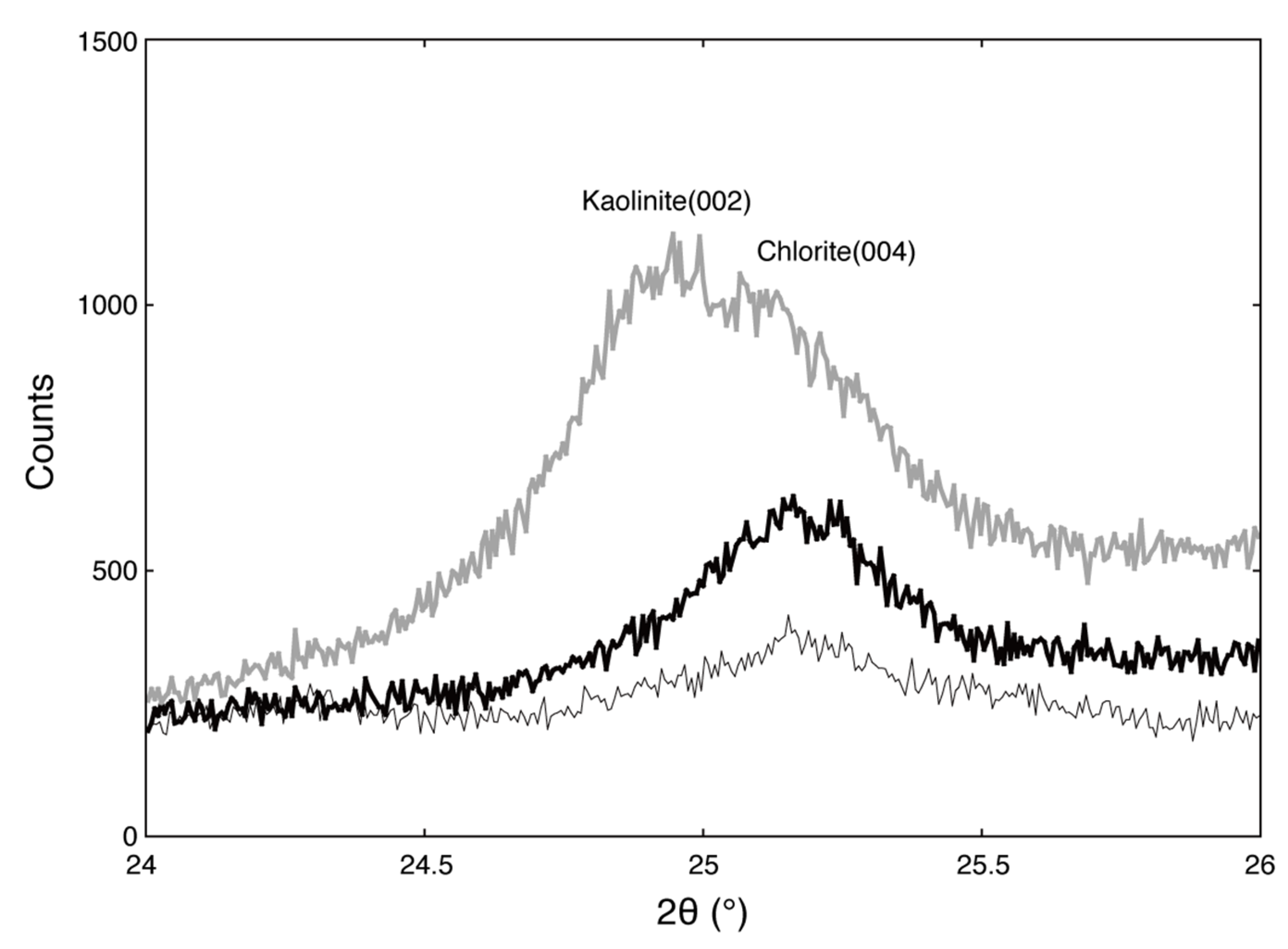
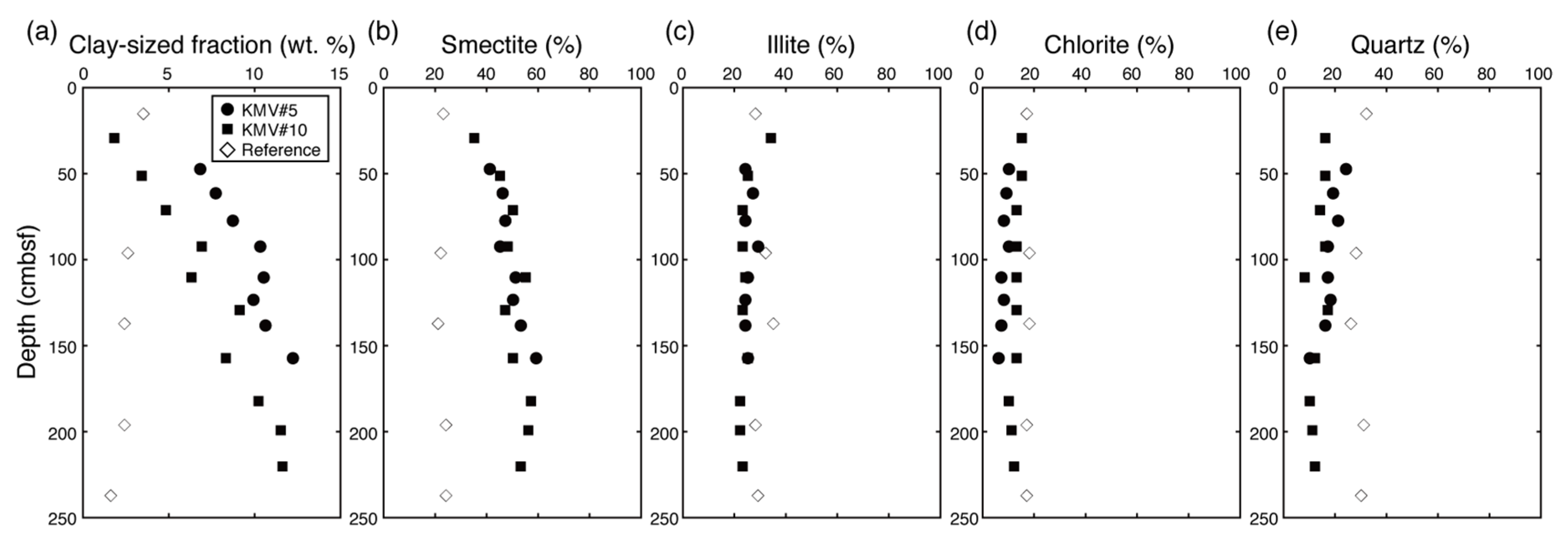

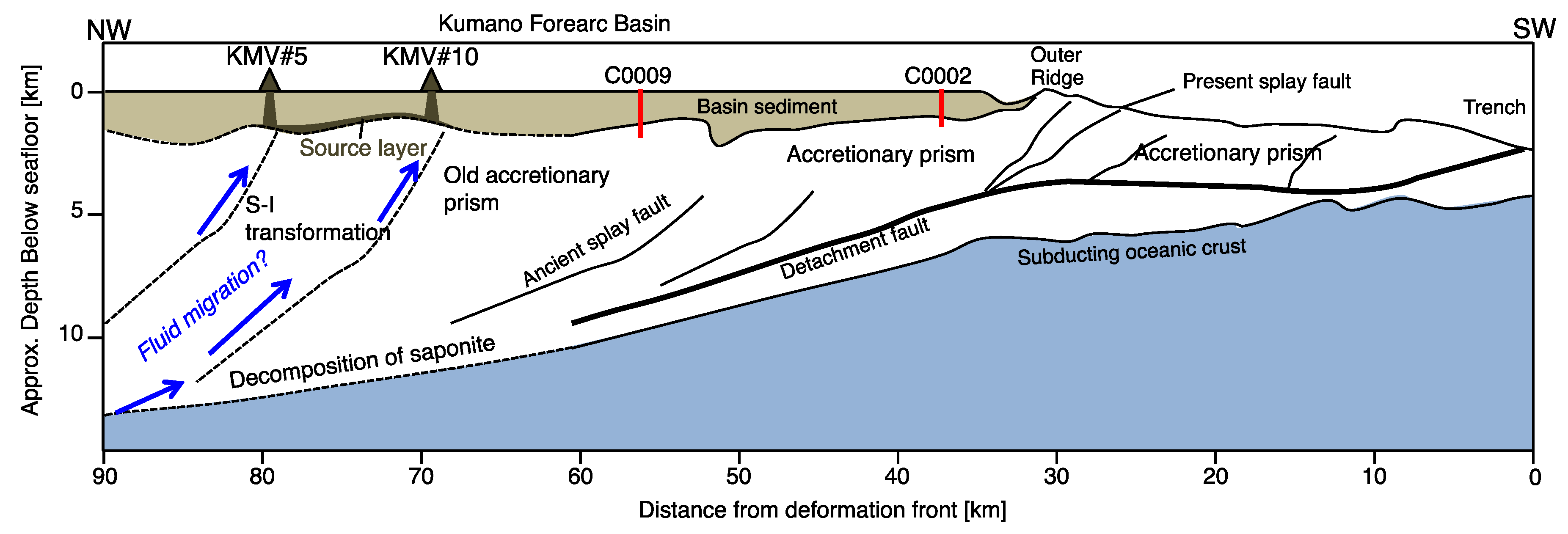
| Integrated Peak Area (Counts) | Estimated Mineral Abundance in Clay-Size Fraction | |||||||||||||||
|---|---|---|---|---|---|---|---|---|---|---|---|---|---|---|---|---|
| Biscaye [21] Factors | Guo and Underwood [19] Factors | |||||||||||||||
| Site | Sample Name | Depth | S | I | C(002) | Q | K | C | K(004)/C(002) | S | I | C + K | S | I | C | Q |
| (cmbsf) | (001) | (001) | +K(001) | (001) | (002) | (004) | (%) | (%) | (%) | (%) | (%) | (%) | (%) | |||
| Reference site | PC12-Sec2-76 cm | 15 | 1146 | 2334 | 2098 | 1206 | - | - | - | 8 | 64 | 29 | 23 | 28 | 17 | 32 |
| PC12-Sec3-26 cm | 96 | 1749 | 2794 | 2314 | 1029 | - | - | - | 10 | 64 | 26 | 22 | 32 | 18 | 28 | |
| PC12-Sec4-26 cm | 196 | 1606 | 2269 | 1994 | 1100 | - | - | - | 11 | 62 | 27 | 24 | 28 | 17 | 31 | |
| PC12-Sec4-67 cm | 137 | 1759 | 3093 | 2375 | 919 | - | - | - | 9 | 66 | 25 | 21 | 35 | 18 | 26 | |
| PC12-Sec4-67B cm | 237 | 1827 | 2645 | 2237 | 1173 | - | - | - | 11 | 63 | 27 | 24 | 29 | 17 | 30 | |
| KMV#5 | PC13-Sec3-43 cm | 47 | 26,884 | 6693 | 3869 | 3346 | - | - | - | 44 | 44 | 13 | 41 | 24 | 10 | 24 |
| PC13-Sec3-57 cm | 61 | 48,162 | 11,047 | 5524 | 3822 | - | - | - | 47 | 43 | 11 | 46 | 27 | 9 | 19 | |
| PC13-Sec3-71 cm | 77 | 45,563 | 8978 | 4254 | 4080 | - | - | - | 51 | 40 | 9 | 47 | 24 | 8 | 21 | |
| PC13-Sec4-10 cm | 92 | 30,761 | 7863 | 4031 | 2231 | - | - | - | 44 | 45 | 11 | 45 | 29 | 10 | 17 | |
| PC13-Sec4-28 cm | 110 | 63,384 | 11,482 | 5167 | 3946 | - | - | - | 53 | 38 | 9 | 51 | 25 | 7 | 17 | |
| PC13-Sec4-41 cm | 123 | 53,183 | 9737 | 4570 | 3785 | - | - | - | 52 | 39 | 9 | 50 | 24 | 8 | 18 | |
| PC13-Sec4-56 cm | 138 | 49,218 | 8262 | 3856 | 2928 | - | - | - | 55 | 37 | 9 | 53 | 24 | 7 | 16 | |
| PC13-Sec4-75 cm | 157 | 68,306 | 10,639 | 5223 | 2633 | - | - | - | 56 | 35 | 9 | 59 | 25 | 6 | 10 | |
| KMV#10 | PC14-Sec2-25 cm | 29 | 12,365 | 5105 | 3524 | 1070 | - | - | - | 31 | 51 | 18 | 35 | 34 | 15 | 16 |
| PC14-Sec3-6 cm | 51 | 36,796 | 7726 | 7674 | 2415 | - | - | - | 44 | 37 | 18 | 45 | 25 | 15 | 16 | |
| PC14-Sec3-26 cm | 71 | 49,275 | 8001 | 7989 | 2626 | 2824 | 47,814 | 0.059 | 51 | 33 | 16 | 50 | 23 | 13 | 14 | |
| PC14-Sec3-47 cm | 92 | 49,574 | 8841 | 8680 | 3088 | 3419 | 51,595 | 0.066 | 48 | 35 | 17 | 48 | 23 | 13 | 16 | |
| PC14-Sec3-65 cm | 110 | 57,633 | 9162 | 8816 | 2025 | 2417 | 50,794 | 0.048 | 51 | 33 | 16 | 55 | 24 | 13 | 8 | |
| PC14-Sec4-12 cm | 129 | 46,329 | 8454 | 8200 | 3199 | 2840 | 57,185 | 0.050 | 48 | 35 | 17 | 47 | 23 | 13 | 17 | |
| PC14-Sec4-37 cm | 157 | 56,447 | 10,272 | 9386 | 2677 | 3284 | 56,266 | 0.058 | 48 | 35 | 16 | 50 | 25 | 13 | 12 | |
| PC14-Sec4-54 cm | 182 | 70,632 | 9904 | 8040 | 2859 | 2830 | 46,804 | 0.060 | 56 | 31 | 13 | 57 | 22 | 10 | 10 | |
| PC14-Sec4-75 cm | 199 | 72,661 | 10,264 | 8789 | 3156 | 3265 | 51,381 | 0.064 | 55 | 31 | 13 | 56 | 22 | 11 | 11 | |
| PC14-Sec4-84 cm | 220 | 61,886 | 9713 | 8504 | 2873 | 2346 | 55,604 | 0.042 | 53 | 33 | 14 | 53 | 23 | 12 | 12 | |
© 2018 by the authors. Licensee MDPI, Basel, Switzerland. This article is an open access article distributed under the terms and conditions of the Creative Commons Attribution (CC BY) license (http://creativecommons.org/licenses/by/4.0/).
Share and Cite
Ijiri, A.; Iijima, K.; Tsunogai, U.; Ashi, J.; Inagaki, F. Clay Mineral Suites in Submarine Mud Volcanoes in the Kumano Forearc Basin, Nankai Trough: Constraints on the Origin of Mud Volcano Sediments. Geosciences 2018, 8, 220. https://doi.org/10.3390/geosciences8060220
Ijiri A, Iijima K, Tsunogai U, Ashi J, Inagaki F. Clay Mineral Suites in Submarine Mud Volcanoes in the Kumano Forearc Basin, Nankai Trough: Constraints on the Origin of Mud Volcano Sediments. Geosciences. 2018; 8(6):220. https://doi.org/10.3390/geosciences8060220
Chicago/Turabian StyleIjiri, Akira, Koichi Iijima, Urumu Tsunogai, Juichiro Ashi, and Fumio Inagaki. 2018. "Clay Mineral Suites in Submarine Mud Volcanoes in the Kumano Forearc Basin, Nankai Trough: Constraints on the Origin of Mud Volcano Sediments" Geosciences 8, no. 6: 220. https://doi.org/10.3390/geosciences8060220
APA StyleIjiri, A., Iijima, K., Tsunogai, U., Ashi, J., & Inagaki, F. (2018). Clay Mineral Suites in Submarine Mud Volcanoes in the Kumano Forearc Basin, Nankai Trough: Constraints on the Origin of Mud Volcano Sediments. Geosciences, 8(6), 220. https://doi.org/10.3390/geosciences8060220





